Some people look forward to traveling during the winter holidays as a chance to get away from family, work, and inclement weather. Exotic, sun-drenched destinations ranging from Florida, Hawaii, and Mexico to a well-chosen Caribbean cruise can seem like perfect winter getaways in their planning stages. But with Puerto Rico having been ravaged by Hurricane Irma, Bali under threat of violent volcanic eruptions, and snow in Texas, boarding packed planes filled with passengers unintentionally bearing germs as holiday gifts may not seem like the perfect way to enjoy a vacation.
Those who dread traveling close to the winter solstice know full well how easy it is for even the best-laid travel plans to be ruined by unexpected blizzards, people who are still at work but have no qualms about interrupting a colleague's vacation with niggling questions, or time spent with friends and relatives whose prying, politics, racism, and holiday-triggered hostility do little to promote "peace on earth and goodwill to all men." Perhaps that's why so many people wish they could find a way to get away from it all.
If you're not in the mood to deal with holiday crowds, December is a perfect time to settle down with the books you've been meaning to read, attend to projects you've been hoping to start, watch movies you've been aching to catch up on, or indulge in a series of cozy, rejuvenating naps. Perhaps you've been struggling with seasonal affective disorder (SAD) and holing up at home in a funk. If so, here's some holiday advice from the younger generation (consider the source).
What if you're too restless for an armchair adventure and feel that you've reached your limit with such traditional holiday attractions as The Nutcracker, Handel's Messiah, or a performance of A Christmas Carol? Why not treat yourself instead to the kind of storytelling that never loses its magic or sense of wonder?
* * * * * * * * *
For its 2017 holiday show at the Lucie Stern Theatre in Palo Alto, TheatreWorks Silicon Valley chose Mark Brown's adaptation of Jules Verne's beloved 1873 novel, Around the World in 80 Days. First produced at the Utah Shakespeare Festival in 2001, this dramatization is very much in the style of recent TheatreWorks productions of The 39 Steps and The Hound of the Baskervilles. As the company's artistic director, Robert Kelley, is quick to point out:
"While many of Verne’s most popular novels were brilliant science fiction, Around the World in 80 Days was a celebration of a just-achieved reality of the 1870s: the possibility of circling the globe entirely via man-made inventions (steam trains crossing entire continents and steamships sailing vast oceans at unheard of speeds). If such travel was the exhilarating technology of its day, Verne foresaw its challenges; one leg of his journey was taken by default via ancient means (an elephant across India) while another accessed a truly retro contraption: a sail-driven sledge racing across the snow-covered plains of Nebraska."
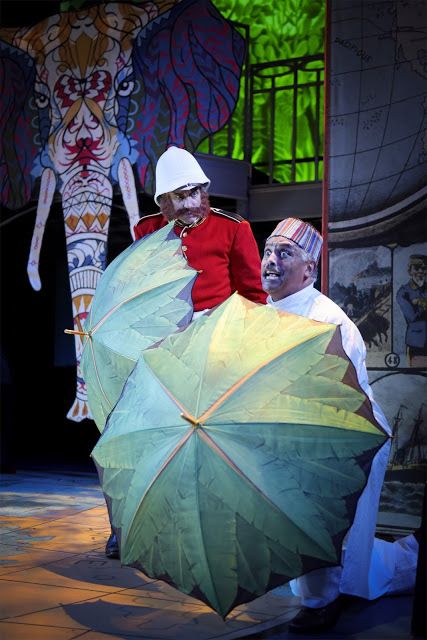
Ron Campbell (Sir Francis) and Michael Gene Sullivan in a scene from Around the World in 80 Days
"Our theatrical adaptation of Verne’s novel chronicles a rare moment in history when international travel and global communication vastly expanded in a remarkably short period of time. Here in Silicon Valley, 150 years later, we are the creators and inheritors of just such a moment: we launched both personal computing and the Internet in less than a decade, vastly expanding global communication and interaction in the process. If Jules Verne captured the sense of adventure, innovation, and progress that defined his era, he also defined our own."
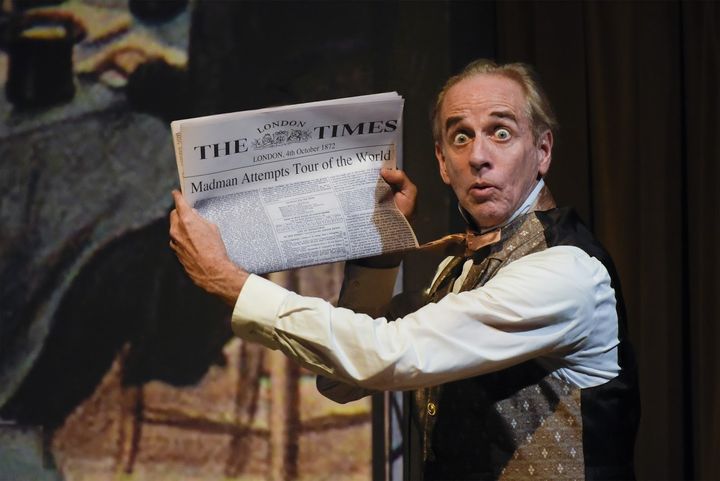
Ron Campbell in a scene from Around the World in 80 Days
Although numerous adaptations of Verne's novel ranging from the 1919 silent film starring Conrad Veidt to a 1989 television miniseries starring Pierce Brosnan (as well as a 2004 remake starring Steve Coogan and Jackie Chan) have entertained audiences, film and cartoon versions of his global travel marathon can do much more with visuals than a live stage adaptation. Those who saw Mike Todd's 1956 blockbuster starring David Niven and Cantinflas (with a host of Hollywood celebrities in supporting roles) will no doubt remember its theme song, which became a big hit on radio stations at the time.
Brown's version keeps five performers busily acting out Verne's tale while making a series of fast costume changes as the protagonist, Phileas Fogg (Jason Kuykendall) and his sidekick, Passepartout (Tristan Cunningham), race around the world by air, land, and sea. As in several other productions he has designed for TheatreWorks Silicon Valley, Joe Ragey enhances the action on his multi-level main structure with rear projections of subtle beauty and an amusingly-painted central drop with hidden windows which (along with two charming side panels) add a touch of period whimsy to his overall design concept.
With costumes by B. Modern and lighting by Steven B. Mannshardt, director Robert Kelley keeps his actors moving at a rapid pace. The combination of sound design by Cliff Caruthers with Foley and other special effects by Cameron Wells frequently jolts the audience to attention with a cacophony of train whistles and other delightful reminders of the sounds and machines that ruled the 1870s. The production's one weakness is a lack of incidental music which could put "buttons" on certain scenes that, in their current form, evaporate into thin air without sufficient dramatic punctuation.
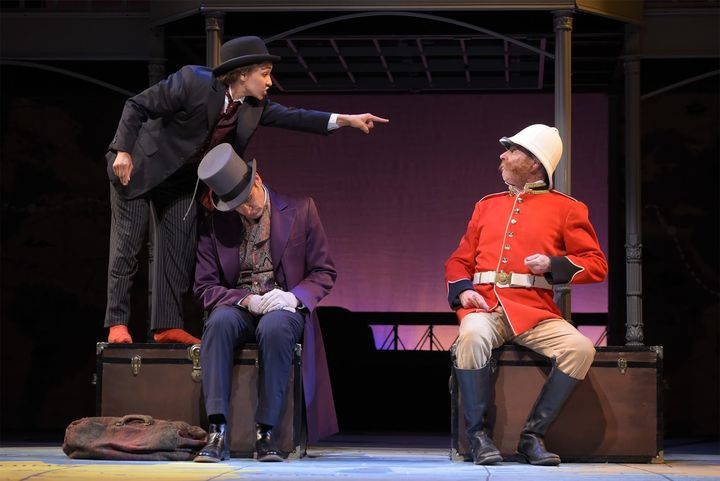
Tristan Cunningham (Passepartout), Jason Kuykendall (Fogg), and Ron Campbell (Sir Francis) in a scene from Around the World in 80 Days
While experienced clowns like Ron Campbell and Michael Gene Sullivan easily transition between a wide variety of costumes and foreign accents, the character of Phileas Fogg remains surprising stiff and clinical throughout much of the performance. As Kelley rightfully notes:
"A 19th century embodiment of geek culture, Fogg approaches life by the book, by the clock, and by the conviction that a dispassionate scientific approach can give life meaning. His eighty days abroad will offer him a fascinating choice between control and collaboration, between an isolation he never regretted and a partnership he never imagined. Love. It’s a choice that goes beyond science, beyond control, beyond time -- a choice that defines humanity."
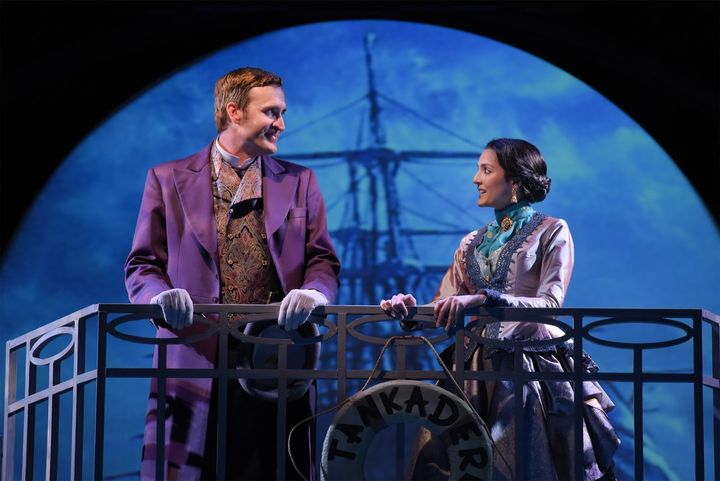
Jason Kuykendall (Phileas Fogg) and Ajna Jai (Aouda) in a scene from Around the World in 80 Days
Thanks to their linguistic, dramatic, and athletic versatility, Ron Campbell and Tristan Cunningham add plenty of spark to the production. Jason Kuykendall and Ajna Jai hold up the glamour side of the evening (I was particularly impressed with Ms. Jai's costumes). Michael Gene Sullivan shows his skill as a bumbling jack-of-all-trades .
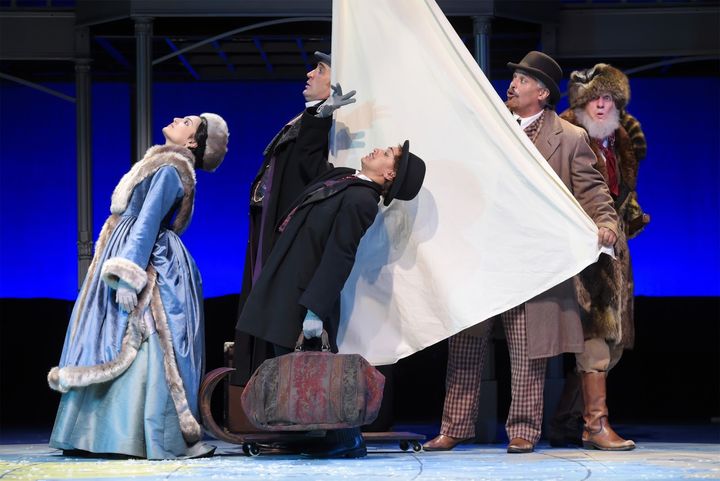
Ajna Jai, Jason Kuykendall, Tristan Cunningham, Michael Gene Sullivan, and Ron Campbell in a scene from Around the World in 80 Days
Performances of Around the World in 80 Days continue through December 31 at the Lucie Stern Theatre in Palo Alto (click here for tickets).
* * * * * * * * *
With the technological prowess of today's animation software, it's easy to forget that animation did not begin with Walt Disney's hand-painted cels. To open its December 2nd "Day of Silents," the San Francisco Silent Film Festival presented a screening of The Adventures of Prince Achmed, a film by Lotte Reiniger which now stands as the longest-surviving piece of animated film in the world.
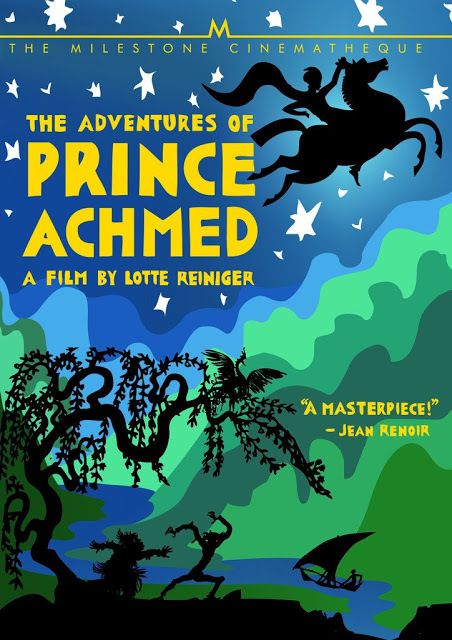
Poster art for 1926's The Adventures of Prince Achmed
Written and directed by Reiniger, The Adventures of Prince Achmed is based on stories take from 1001 Arabian Nights. While the storytelling is as wonderful as ever, Reiniger's artwork is simply stunning. The intricacy of her hand-cut silhouettes, the imaginative ways in which she demonstrates how plants can be transformed into humans (and how palaces can fly through the air) offer a stark reminder of the skill and patience required to create an animated film with little more than paper and scissors.
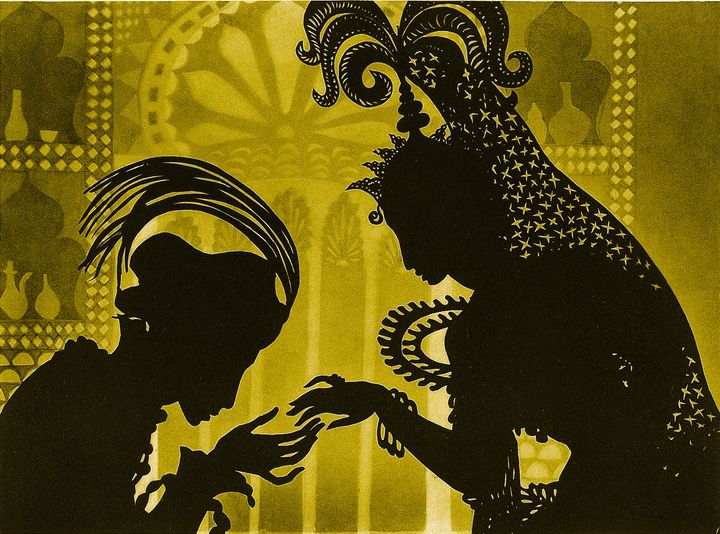
A scene from 1926's silent film, The Adventures of Prince Achmed
Born on June 2, 1899 in Berlin, Reiniger began working with her husband, Carl Koch, in 1921 and became friends with such rising theatre artists as Bertolt Brecht. Later in life, the self-taught filmmaker wrote:
“I could cut out silhouettes almost as soon as I could manage to hold a pair of scissors. I could paint, too, and read and recite. These things did not surprise anyone very much, but everybody was astonished about the scissor cuts. With each new film, we could make new discoveries. The whole field was virgin soil and we had all the joys of explorers in an unknown country."
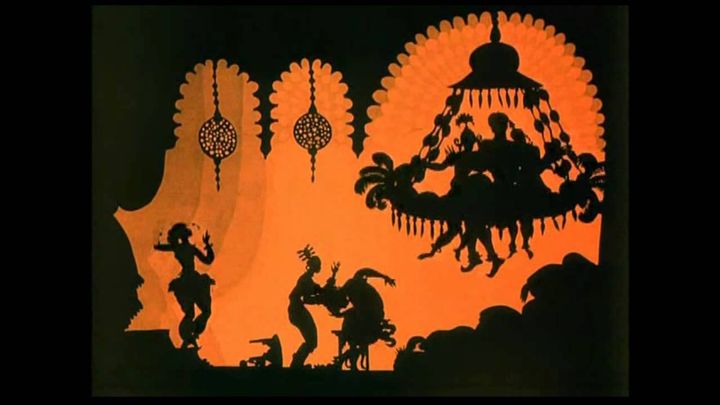
A scene from 1926's silent film, The Adventures of Prince Achmed
In her essay about The Adventures of Prince Achmed, film historian Shari Kizirian wrote:
"Lotte Reiniger mastered silhouettes as a child, entertaining the family with Shakespeare shadow plays in the living room. She embodied the credo of the new age: a self-taught artist skilled in the ancient folk art of shadow plays, who was excited by the prospect of cinema. One frame at a time, Reiniger would adjust the moving parts of her elaborate silhouette puppets, cut from black cardboard and joined by wire hinges. She studied human and animal movements to make her characters as expressive as possible."
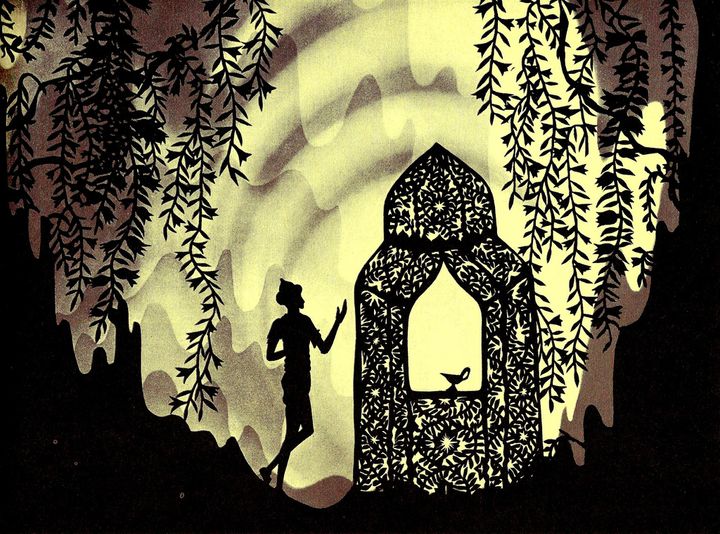
A scene from 1926's silent film, The Adventures of Prince Achmed
"Louis Hagen installed them above his garage in Potsdam, where they spent the next three years photographing 250,000 individual images on a multi-plane camera designed specifically for the film. The multi-plane camera, operated by Carl Koch, sat atop two layers of glass tables, with a strong backlight at the bottom to give the images depth. The background artists experimented with effects of their own: Berthold Bartosch created ocean waves and starlit skies with sand, soap and transparent cutouts; and Walther Ruttmann used wax to conjure the flying horse and other magical transformations. As the camera was stationary, larger silhouettes and scaled backgrounds also had to be built for medium shots or close-ups. A total of 96,000 frames were culled from the filming, then edited together."

A scene from 1926's silent film, The Adventures of Prince Achmed
In a year that has been marked by political tension, anxiety, natural disasters and, for many, feelings of hopelessness and helplessness, The Adventures of Prince Achmed offers sorely-needed doses of beauty, charm, amazement, and delight. Consider it the positive equivalent of "shock and awe."
The following hour-long documentary entitled Lotte Reiniger: Homage to the Inventor of the Silhouette Film traces the career path of the remarkable woman who created a genre of film using paper cutouts and went on to make 80 films, most of which were inspired by fairy tales (Cinderella, Jack and the Beanstalk, The Goose That Lays the Golden Eggs, The Chinese Nightingale) and operas (The Magic Flute, Tosca, Carmen).
